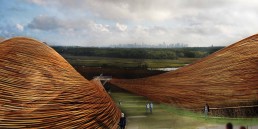FRESH KILLS COASTER
Submission to the 2012 Land Art Generator Initiative NYC design competition
Artist Team: Jason Shannon, Paola Yanez
Artist Location: Jersey City, USA
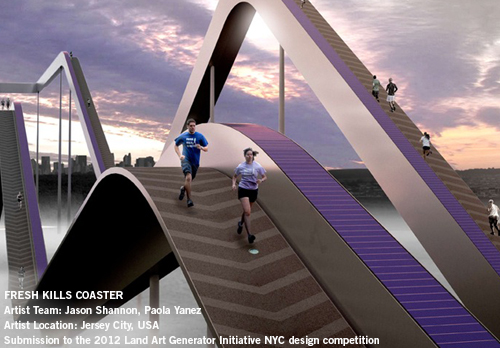
Artist Descriptive Text:
The concept of an energy producing sculpture is certainly a step in the right direction towards energy sustainability and public awareness. But energy sustainability is just part of a broader idea of mankind’s struggle to sustain themselves with the limited resources we have on our planet. Simply put, all these sustainable or “green” ideas are our attempt to find balance with nature.
This last winter, there was an article in the NY Times that described a surprise sighting of a possum on the NYC subway. It was a good example of how awkward our built environment has made the existence of plants and animals that have thrived in this area for thousands of years. Yes, man has built great things, but we have also destroyed much of the natural ecosystem for sprawling suburbs, strip malls, and parking lots. Our mentality toward the natural environment has been to take everything we can get our hands on. Our proposal suggests that mankind’s strategy should be based more on mutual respect, because we need nature more than it needs us.
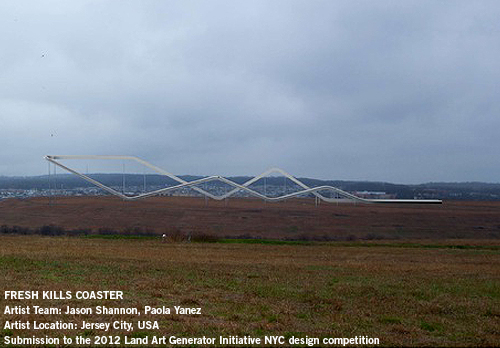
Our proposal for the LAGI competition is the Fresh Kills Coaster. First and foremost it is a wild life refuge. The project designates a section of the Fresh Kills park to be off limits to visitors to give plants and animals the freedom to exist unmolested. The site location was chosen to connect to a larger green area surrounding Fresh Kills. In many ways, building nothing makes sense if preserving nature were the only goal, but it would be unrealistic to think that our sustainability problems will be resolved simply by doing nothing.
The physical aspects of the Fresh Kills Coaster were derived from two ideas. First, that the people of Staten Island have been burdened with a landfill for decades and deserve the ability to experience the Fresh Kills park, and second, with the goals of producing sustainable energy to add power to the local community. In order to give people access to the area designated as a preserve, a raised platform is imagined to separate people from nature. Added to the idea of a raised platform is the need to create sustainable energy. Solar collectors have proven to be both passive in terms of their impact on nature and also effective in producing energy. To be most efficient, solar collectors are ideally sloped toward the sun’s predominate direction to absorb the most solar radiation. The combination of a raised platform and the sloped surface desired for the solar cells resulted in the Fresh Kills Coaster. In this case, the sloped surface used to optimize the solar cells not only added the functionality of the project but also the experiential qualities. The rased platform becomes a challenging climb, akin to a mountain to be conquered. At the same time, the coaster platform becomes the perfect opportunity to incorporate the kinetic converters from the PaveGen corporation. Throughout the coaster, people can use there own bodies to add to the energy creation of the project, literally making people part of the solution.
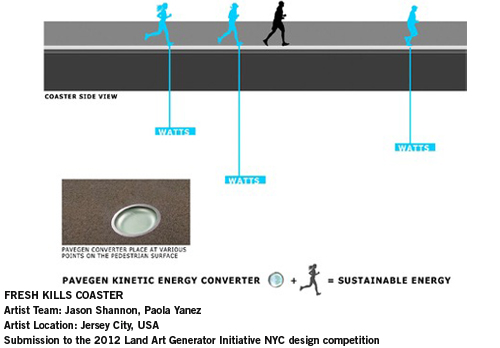
The materiality of the coaster is predominately anodized aluminum. Not only will the aluminum of the coaster contain a significant amount of recycled content, but the skin will be fully recyclable once the life cycle of the project ends. This is similar to the other main component of the project, the steel structure, which can also be fully recycled. The running surface of the coaster is a special product made by Nike that uses old sneakers that are ground up and reconstituted into an athletic surface. Finally the project is designed to be prefabricated which minimizes the construction time on site and the subsequent impact on the natural environment.
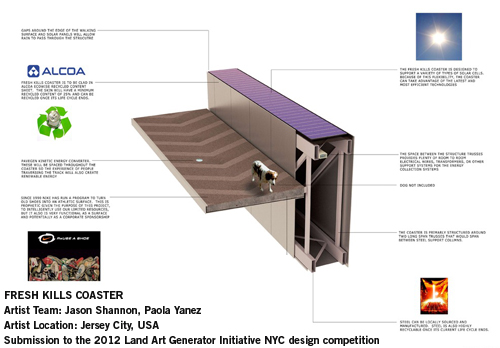
The Fresh Kills Coaster turns what is normally a simple path in a park into an iconic experience that will get people talking about Fresh Kills, energy production, and ecology.

